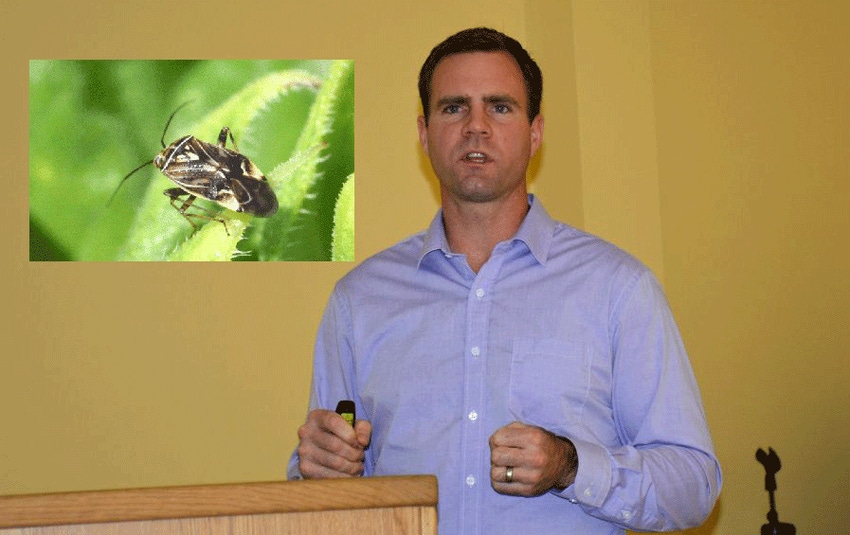
Dominic Reisig tells North Carolina cotton farmers that if they don’t yet have plant bugs, that’s great, but they still need pay attention, scout and expect to have to spray for plant bugs in the future.
“Plant bugs are an increasing problem. Most of our plant bug problems are west of Interstate 95, and they become worse as you get up into the Northeast,” said Reisig, North Carolina State University Extension entomologist, at an Extension cotton production meeting in Rocky Mount Feb. 1.
Plant bugs have been an issue in the Mid-South for many years, and Reisig said many of the integrated pest management approaches used there can work in North Carolina. He said it is critical for North Carolina cotton farmers to manage for earliness, select the right variety and choose the right planting date to effectively manage for plant bugs.
“One huge advantage we have over the Mid-South is we tend to use early maturing varieties. This will help us,” Reisig said. “Varieties can make a huge difference. When you choose your cotton variety, be sure you know if it’s a hairy leaf or smooth leaf variety. Smooth leaf varieties are much more susceptible to plant bugs. Hairy leaf varieties are much more resistant.”
Yield loss from plant bugs tends to be greater in late maturing varieties than early maturing varieties, Reisig said.
“Nitrogen can make a huge difference for plant bugs,” he added. “Of course we need to put nitrogen on the cotton plant, but what we need to do is avoid putting too much nitrogen on the plant. If we put above 80 pounds per acre, the yield flattens and we see more plant bug problems in those higher nitrogen plots.”
Irrigation can create plant bug issues as well. “Plant bugs tend to be attracted to ranker cotton. We are going to have to spray more for plant bugs as we increase our nitrogen rates and increase our irrigation rates,” Reisig said.
Reisig shared research from the Mid-South that shows increasing plant bug resistance to insecticides. The research shows that one spray with one insecticide is not effective in the Mid-South and the same is likely true in North Carolina.
Two or more applications of insecticides will likely be needed, and Reisig said it is critical to rotate products used to avoid resistance.
In the Mid-South, best management practices offer better insect control compared to standard management practices. Reisig said the same is true in North Carolina.
“With best management practices, we need to consider edge effects,” Reisig explained. “We know that cotton is a sink for plant bugs. What I mean by that is plant bugs really aren’t produced very well in cotton. You do have a lot of sources in the environment, and they’re not something we can ever eliminate. Weeds are a huge source. Soybeans are a huge source. But one of the big sources in our environment is corn.”
In the Mid-South best management practices for plant bugs include planting cotton away from corn. Reisig said the same is true for North Carolina.
Reisig continues to stress the importance of scouting, and cotton farmers should scout their fields at least twice a week, particularly if they have rank cotton, late planted cotton or applied excess nitrogen.
“We really want to focus our scouting on squaring through the fifth week of bloom,” Reisig said. “When we square, in terms of insecticide, I recommend a neonicotinoid as a first shot. Once you spray your insecticide go in four days after your spray and see if that’s worked. And think about a follow up spray.”
At first flower, farmers should consider pyretheriods. “I don’t recommend them early on because the pyretheroids tend to knock out the beneficial insects,” Reisig said.
For heavy plant bug pressure, Reisig said farmers should consider adding the insecticide Diamond as well. Diamond targets nymphs and not adults, and proper timing of application is critical.
“Diamond is a unique chemistry because it’s an insect growth regulator. Instead of actually killing the insects themselves, what insect growth regulators do is they inhibit the structures that the insects use when they molt,” Reisig said.” An insect growth regulator is only going to work on a nymph because nymphs have to molt to grow larger to become adults. Once it’s an adult, an insect growth regulator won’t work.”
About the Author(s)
You May Also Like






